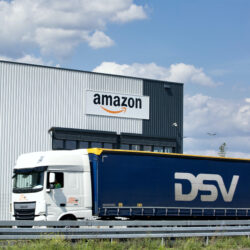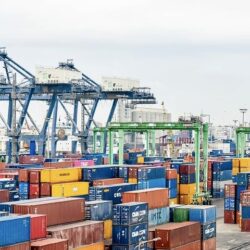In e-commerce, supply chain and business strategy are merging

With a growing number of online retailers now offering to provide third-party logistics to vendors, the boundaries are blurring between e-commerce and logistics. In 2017 we identified a nascent trend in the consumer goods market of moving physical distribution to third-party logistics providers (3PLs). With the growing market share of e-commerce, 3PLs offered a simple and flexible solution just as companies were coming to see physical distribution as a non-core competency. The pandemic has fast-tracked the shift towards omnichannel retail, supercharging the trend of businesses employing 3PLs. This is causing the lines between manufacturer, 3PL, and customer to blur. The repercussions on costs, working capital, and supply chain structures will play out in the coming months and years.
By Richard Markoff and Ralf W. Seifert
Now more than three years have passed since the COVID-19 pandemic first disrupted the world, we are able to take stock of how it has impacted e-commerce. Online sales in Europe are projected to make up 13.6% of total retail sales this year, compared to 10.6% in 2019, the last full year before the pandemic. This represents a 28% increase in online sales over the same period. The growth is even more pronounced in the United States, increasing from 11.1% in 2019 to a projected 17.9% in 2023, where online sales have surged to a remarkable 61%.
For consumer goods companies with distribution networks designed to fulfill order profiles of cases and pallets, this is a huge shift in a very short timeframe. Given the tight labor market environment, it is not surprising that the global revenue of 3PLs has grown over 27% in the same period. This growth is likely fueled by the increased detail-picking and short delivery requirements of e-commerce.
Two trends merge
The boom in e-commerce and correlated growth in 3PLs appears to be converging into a significant trend that is blurring the distinction between traditional retailers and logistics providers. A look at the online retail giant Amazon helps illustrate this point. Amazon is not simply a retailer that happens to sell its suppliers’ products online. For years, Amazon has been offering a solution called Fulfillment by Amazon (FBA), whereby Amazon would store goods for its vendors and prepare/ship orders on their behalf – for a fee, of course.
Simply put, Amazon offers to act as a 3PL for its vendors. It has been a huge success for the company. Revenue from third-party seller services (largely FBA) has doubled from 2019 to 2023. In 2023, it’s estimated that over 90% of vendors use FBA, representing 60% of all units sold on Amazon. Not to be outdone, Amazon’s largest US rival, Walmart, has this year launched Walmart Fulfillment Services, with already 25% of its vendors using the service. In Europe, the largest non-Amazon online retailer, apparel vendor Zalando, has its own variation as well.
For online retailers, there is a lot to like in this model. First, they can leverage their hard-won expertise in preparing and shipping online orders. Second, having a larger catalog and inventory helps them to fully exploit their distribution footprint. And third, since the inventory does not belong to them, it remains on the balance sheet of the vendor. The result is a far more efficient enterprise, both in fixed assets and working capital.
If there were any doubt that this is the future, Amazon recently announced it would impose a 2% fee per item on all vendors who fulfill Prime orders but who are not FBA customers. This means that FBA is no longer just a convenient service for smaller vendors but is being used by the world’s biggest online retailer as part of its competitive strategy.
A complex decision
These developments oblige vendors, who by now all sell through online platforms in some manner, to choose a path forward. The choice is not simply to keep distribution in-house or go to a 3PL but whether e-commerce distribution should specifically be performed by the online retailer. It’s a surprisingly complex multi-variable decision, with dimensions to consider beyond the supply chain.
The first thing for vendors to consider is the staggering increase in inventory levels that would result from working with models like FBA. As the FBA-like warehouses are added to the vendor’s internal distribution network positions, this in turn increases the number of inventory positions a vendor has. If, for example, a vendor has one warehouse for Western Europe and then adopts an FBA-like model that adds another four inventory positions for that online retailer business, the result would be a doubling of the inventory level for no increase in demand.
These incremental inventory positions would not only increase the vendor’s working capital requirements. Maintaining inventory accuracy means ongoing coordination of transactions such as stock reconciliation, scrap and return movements, and quality status updates. The vendor would also have to establish interfaces for this data, as well as product master data. These interface requirements often expose weaknesses in the vendor’s master data management policies and execution that would have to be addressed in very short order. All of this implies that a move to an FBA-like fulfillment model implies higher working capital, higher complexity, more personnel, and a high-complexity operational business environment.
And this is just the case if a vendor only works with one FBA-like fulfillment partner. Since vendors in fact work with several online retailers, each looking to incentivize vendors to use their platform, the impacts would be multiplied many times over, resulting in a terrifyingly complex web of interfaces and inventory, all of which is not interchangeable if (and when) demand between regions and retailers provides surprises. FBA and its competitors are capable of serving orders originating from other online retail platforms, but it appears to be unwieldy – and in any case, competitors are expressing concerns over conflicts of interest. For example, if FBA is fulfilling orders originating from walmart.com it is understandable that Walmart would be concerned that Amazon could gain consumer insights from the first-party data now available to them.
The changes are not over
With consumer goods companies already confronted with a knotty, tricky decision to make, Zalando is going even further in blurring the lines between retailer and 3PL. Zalando, like Amazon, already offered to fulfill orders not originating from their platforms, such as Spotify or Etsy.
Zalando is now expanding its services as a third-party logistics provider to fashion and lifestyle brands, regardless of whether they sell on Zalando or not, aiming to leverage its distribution network and expertise to become a standalone e-commerce 3PL, as well as an online retailer, consignment retailer, data consultant, and 3PL.
It’s reasonable to imagine this trend will continue, with unpredictable impacts moving forward on distribution footprints and working capital. This is yet another chapter in the ongoing story of supply chain transformation we have witnessed in recent years. And just as importantly, it is yet another instance of supply chain considerations being at the heart of the business strategy.
This article was first published by IMD on December 7, 2023.
Richard Markoff is a supply chain researcher, consultant, coach, and lecturer. He has worked in supply chain for L’Oréal for 22 years, in Canada, the US and France, spanning the entire value chain from manufacturing to customer collaboration. He is also Co-Founder and Operating Partner of the Venture Capital firm Innovobot.
Ralf W. Seifert is Professor of Operations Management at IMD and co-author of The Digital Supply Chain Challenge: Breaking Through. He directs IMD’s Leading the Future Supply Chain (LFSC) program, which addresses both traditional supply chain strategy and implementation issues as well as digitalization trends and the impact of new technologies.










